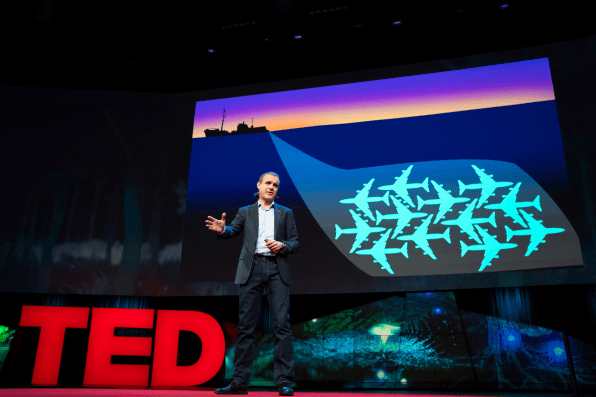In 1999, Cabo Pulmo, Mexico, was “an underwater desert,” says marine ecologist Enric Sala. The region’s fishing industry had depleted the waters of fish and nearly its entire marine ecosystem. So the fishermen made a radical decision: to stop fishing entirely. They created a national park in the sea, a massive no-fishing zone across the whole depleted area. Ten years later, Sala says, “what had been an underwater barren was now a kaleidoscope.” Fish had returned en masse, as had large predators and underwater flora.
The ocean has incredible regenerative qualities, Sala says during a talk at TED 2018 in Vancouver. But we’re not doing enough to allow the seas to heal themselves. Today, Sala says, “if you were to jump into any random spot in the ocean, you’d probably see emptiness–we’ve taken fish out of the water faster than we can reproduce.” Sala, currently an explorer-in-residence at National Geographic, is obsessed with this problem: Since witnessing the restoration at Cabo Pulmo he has since worked with his team at National Geographic to document and study similar protected zones in the ocean. “These places are the Yellowstones and Serengetis of the sea–places where you jump in the water and are immediately surrounded by sharks,” he says. “This is a good thing.”
But only 2% of the seas today are protected. Studies have shown we need to protect 30% of the oceans in order to sustain both marine life and life on land.

Sala reasoned that if decades of environmentalist warnings were not sufficient to protect the seas adequately, he would have to turn to economics to prove the case. He presented his economic case for wholesale ocean protection for the first time at TED.
His strategy involved interrogating the process of high-sea fishing. The high seas are the parts of ocean 200 miles out from the shore–closer to land, coastal countries claim jurisdiction over the waters, but no countries own or manage the high seas. As such, damaging illegal fishing practices have proliferated across those waters. Deep-sea trawling, for instance, involves dragging nets large enough to hold a dozen 747 jets across the ocean floor, scraping up ancient coral reefs and entrapping all marine wildlife, not just fish.
“Until now, it was very difficult to know exactly who is fishing the high seas, because countries are very secretive about it,” Sala says. But satellite technology has now enabled his team to track 3,600 individual boats through the oceans. His team tracked the movement of the boat and their activities, and investigated not only which countries were fishing the high seas, but also who benefits from it.
“China, Japan, Korea, Thailand, and Spain alone account for 80% of fishing in the high seas,” Sala says. “We know how much the countries are fishing, and because we also know the price of fish, we’ve been able to map the revenue from fishing on the high seas.”
What Sala found was that not only is fishing not incredibly profitable–the price of the fish caught on the high seas only recuperates the cost of fishing around 50% of the time–but that it often depends on large government subsidies and forced labor to sustain. “What sane government would fund an industry that relies on exploitation, destruction, and is not very profitable? Sala says.
He has a different proposal for governments: Closing the high seas entirely to fishing. The waters currently account for only 5% of overall catch because they are not as productive as the more coastal seas. High seas fishing, consequently, does not contribute to global food security. Closing those waters to fishing, Sala says, would allow the marine environments to regenerate, which in turn would boost the health of the coastal waters closer to shore that fall under the jurisdiction of coastal countries. That would make fishing those waters less costly, more profitable, and more sustainable. Negotiators at the U.N., Sala concludes, will soon begin discussions on a new agreement to turn these recommendations into policy.
(21)